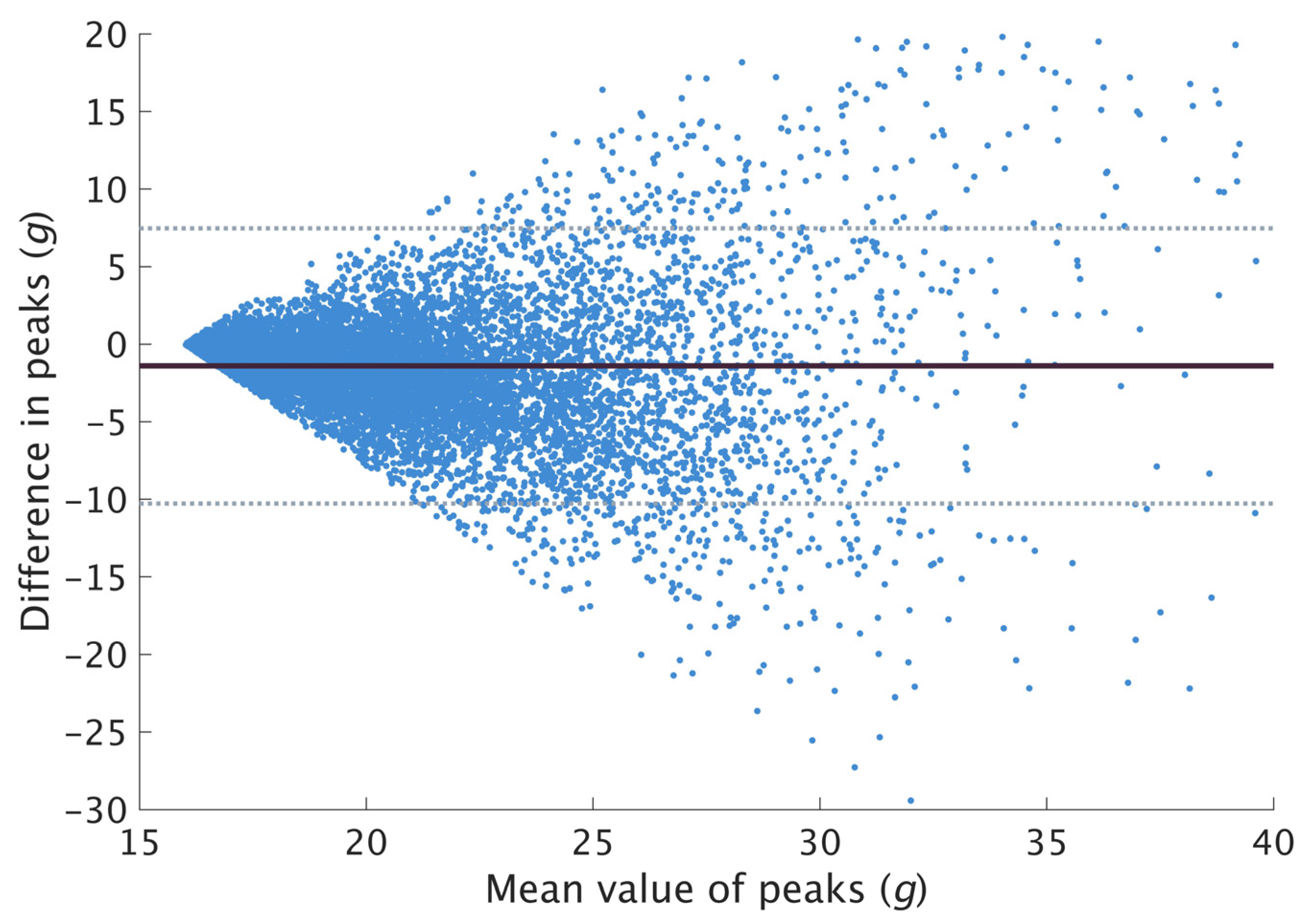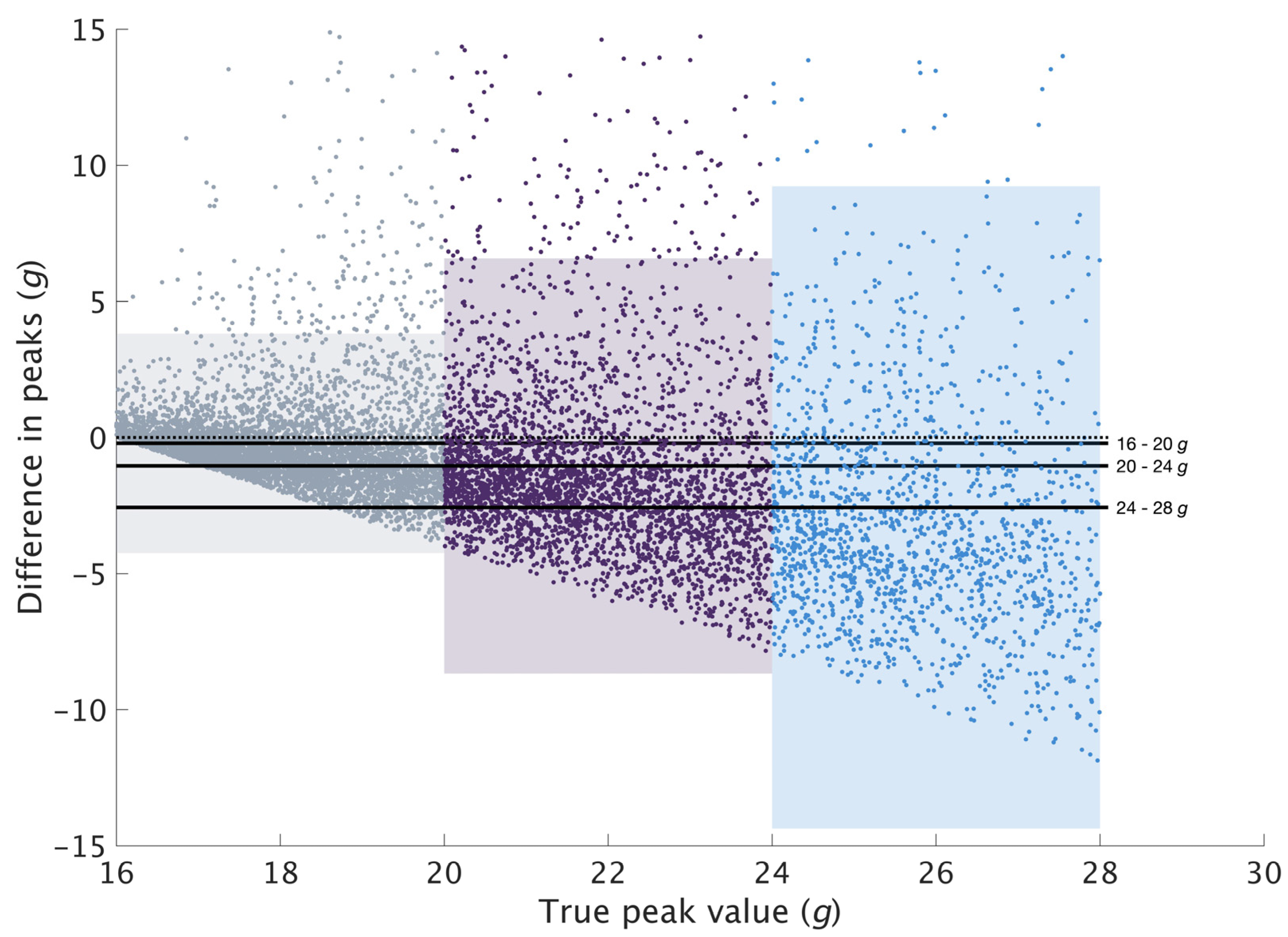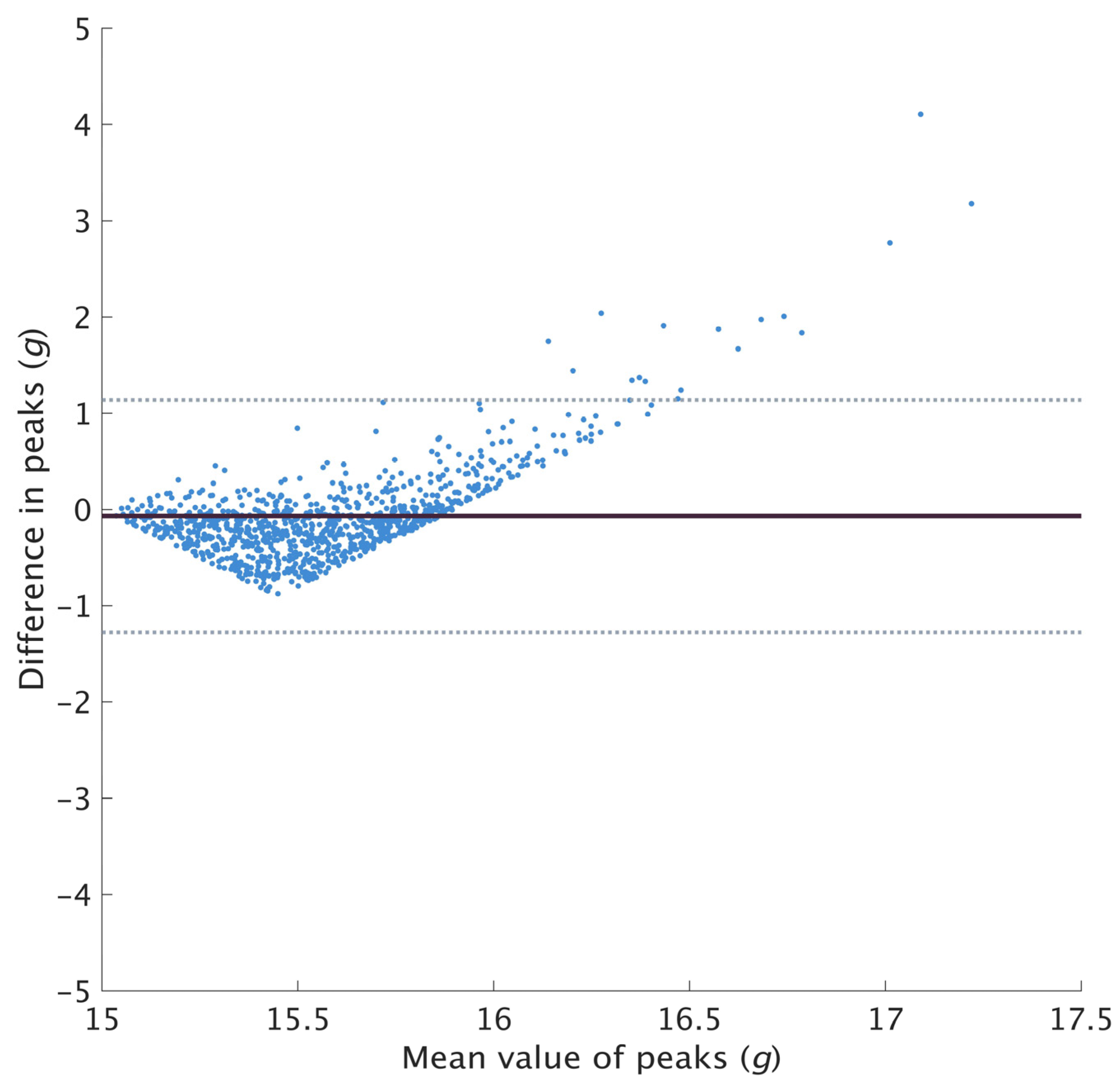Evaluation of a Restoration Algorithm Applied to Clipped Tibial Acceleration Signals
Abstract
1. Introduction
2. Materials and Methods
3. Results
3.1. Two-Sample t-Tests
3.2. Measurement Agreement of Axial PTA
3.3. Measurement Agreement of Resultant PTA
3.4. Artificially Clipped Signal (15.0–15.9 g)
4. Discussion
5. Conclusions
Supplementary Materials
Author Contributions
Funding
Institutional Review Board Statement
Informed Consent Statement
Data Availability Statement
Acknowledgments
Conflicts of Interest
References
- Hulteen, R.M.; Smith, J.J.; Morgan, P.J.; Barnett, L.M.; Hallal, P.C.; Colyvas, K.; Lubans, D.R. Global Participation in Sport and Leisure-Time Physical Activities: A Systematic Review and Meta-Analysis. Prev. Med. 2017, 95, 14–25. [Google Scholar] [CrossRef] [PubMed]
- Cavanagh, P.R.; Lafortune, M.A. Ground Reaction Forces in Distance Running. J. Biomech. 1980, 13, 397–406. [Google Scholar] [CrossRef] [PubMed]
- Benson, L.C.; Clermont, C.A.; Ferber, R. New Considerations for Collecting Biomechanical Data Using Wearable Sensors: The Effect of Different Running Environments. Front. Bioeng. Biotechnol. 2020, 8, 86. [Google Scholar] [CrossRef] [PubMed]
- Milner, C.E.; Hawkins, J.L.; Aubol, K.G. Tibial Acceleration during Running Is Higher in Field Testing Than Indoor Testing. Med. Sci. Sport. Exerc. 2020, 52, 1361–1366. [Google Scholar] [CrossRef]
- Dillon, S.; Burke, A.; Whyte, E.F.; O’Connor, S.; Gore, S.; Moran, K.A. Are Impact Accelerations during Treadmill Running Representative of Those Produced Overground? Gait Posture 2022, 98, 195–202. [Google Scholar] [CrossRef]
- Van den Berghe, P.; Six, J.; Gerlo, J.; Leman, M.; De Clercq, D. Validity and Reliability of Peak Tibial Accelerations as Real-Time Measure of Impact Loading during over-Ground Rearfoot Running at Different Speeds. J. Biomech. 2019, 86, 238–242. [Google Scholar] [CrossRef]
- Nedergaard, N.J.; Verheul, J.; Drust, B.; Etchells, T.; Lisboa, P.; Robinson, M.A.; Vanrenterghem, J. The Feasibility of Predicting Ground Reaction Forces during Running from a Trunk Accelerometry Driven Mass-Spring-Damper Model. PeerJ 2018, 6, e6105. [Google Scholar] [CrossRef]
- Fortune, E.; Morrow, M.M.B.; Kaufman, K.R. Assessment of Gait Kinetics Using Tri-Axial Accelerometers. J. Appl. Biomech. 2014, 30, 668–674. [Google Scholar] [CrossRef]
- Lafortune, M.A. Three-Dimensional Acceleration of the Tibia during Walking and Running. J. Biomech. 1991, 24, 877–886. [Google Scholar] [CrossRef]
- Mason, R.; Pearson, L.T.; Barry, G.; Young, F.; Lennon, O.; Godfrey, A.; Stuart, S. Wearables for Running Gait Analysis: A Systematic Review. Sport. Med. 2023, 53, 241–268. [Google Scholar] [CrossRef]
- Tenforde, A.S.; Hayano, T.; Jamison, S.T.; Outerleys, J.; Davis, I.S. Tibial Acceleration Measured from Wearable Sensors Is Associated with Loading Rates in Injured Runners. PM R 2020, 12, 679–684. [Google Scholar] [CrossRef] [PubMed]
- García-Pérez, J.A.; Pérez-Soriano, P.; Llana Belloch, S.; Lucas-Cuevas, A.G.; Sánchez-Zuriaga, D. Effects of Treadmill Running and Fatigue on Impact Acceleration in Distance Running. Sport. Biomech. 2014, 13, 259–266. [Google Scholar] [CrossRef] [PubMed]
- Mitschke, C.; Kiesewetter, P.; Milani, T.L. The Effect of the Accelerometer Operating Range on Biomechanical Parameters: Stride Length, Velocity, and Peak Tibial Acceleration during Running. Sensors 2018, 18, 130. [Google Scholar] [CrossRef] [PubMed]
- Ruder, M.; Jamison, S.T.; Tenforde, A.; Mulloy, F.; Davis, I.S. Relationship of Foot Strike Pattern and Landing Impacts during a Marathon. Med. Sci. Sport. Exerc. 2019, 51, 2073–2079. [Google Scholar] [CrossRef]
- Johnson, C.D.; Outerleys, J.; Jamison, S.T.; Tenforde, A.S.; Ruder, M.; Davis, I.S. Comparison of Tibial Shock during Treadmill and Real-World Running. Med. Sci. Sport. Exerc. 2020, 52, 1557–1562. [Google Scholar] [CrossRef] [PubMed]
- Sheerin, K.R.; Reid, D.; Besier, T.F. The Measurement of Tibial Acceleration in Runners—A Review of the Factors That Can Affect Tibial Acceleration during Running and Evidence-Based Guidelines for Its Use. Gait Posture 2019, 67, 12–24. [Google Scholar] [CrossRef]
- Sheerin, K.R.; Besier, T.F.; Reid, D. The Influence of Running Velocity on Resultant Tibial Acceleration in Runners. Sport. Biomech. 2020, 19, 750–760. [Google Scholar] [CrossRef]
- Garcia, M.C.; Gust, G.; Bazett-Jones, D.M. Tibial Acceleration and Shock Attenuation While Running over Different Surfaces in a Trail Environment. J. Sci. Med. Sport 2021, 24, 1161–1165. [Google Scholar] [CrossRef]
- Cohen, J. Statistical Power Analysis for the Behavioral Sciences, 2nd ed.; L. Erlbaum Associates: Hillsdale, NJ, USA, 1988; ISBN 978-0-8058-0283-2. [Google Scholar]
- McLaughlin, P. Testing Agreement between a New Method and the Gold Standard-How Do We Test? J. Biomech. 2013, 46, 2757–2760. [Google Scholar] [CrossRef]
- Bland, J.M.; Altman, D.G. Measuring Agreement in Method Comparison Studies. Stat. Methods Med. Res. 1999, 8, 135–160. [Google Scholar] [CrossRef]
- Mo, S.; Chan, Z.Y.S.; Lai, K.K.Y.; Chan, P.P.-K.; Wei, R.X.-Y.; Yung, P.S.-H.; Shum, G.; Cheung, R.T.-H. Effect of Minimalist and Maximalist Shoes on Impact Loading and Footstrike Pattern in Habitual Rearfoot Strike Trail Runners: An in-Field Study. Eur. J. Sport Sci. 2021, 21, 183–191. [Google Scholar] [CrossRef] [PubMed]
- Waite, N.; Goetschius, J.; Lauver, J.D. Effect of Grade and Surface Type on Peak Tibial Acceleration in Trained Distance Runners. J. Appl. Biomech. 2020, 37, 2–5. [Google Scholar] [CrossRef] [PubMed]
- Boey, H.; Aeles, J.; Schütte, K.; Vanwanseele, B. The Effect of Three Surface Conditions, Speed and Running Experience on Vertical Acceleration of the Tibia during Running. Sport. Biomech. 2017, 16, 166–176. [Google Scholar] [CrossRef]
- Zhang, J.H.; Chan, Z.Y.S.; Au, I.P.H.; An, W.W.; Cheung, R.T.H. Can Runners Maintain a Newly Learned Gait Pattern Outside a Laboratory Environment Following Gait Retraining? Gait Posture 2019, 69, 8–12. [Google Scholar] [CrossRef]
- Van den Berghe, P.; Derie, R.; Bauwens, P.; Gerlo, J.; Segers, V.; Leman, M.; De Clercq, D. Reducing the Peak Tibial Acceleration of Running by Music-Based Biofeedback: A Quasi-Randomized Controlled Trial. Scand. J. Med. Sci. Sport. 2022, 32, 698–709. [Google Scholar] [CrossRef] [PubMed]
- Sheerin, K.R.; Reid, D.; Taylor, D.; Besier, T.F. The Effectiveness of Real-Time Haptic Feedback Gait Retraining for Reducing Resultant Tibial Acceleration with Runners. Phys. Ther. Sport 2020, 43, 173–180. [Google Scholar] [CrossRef]
- Vernillo, G.; Giandolini, M.; Edwards, W.B.; Morin, J.-B.; Samozino, P.; Horvais, N.; Millet, G.Y. Biomechanics and Physiology of Uphill and Downhill Running. Sport. Med. 2016, 47, 615–629. [Google Scholar] [CrossRef]
- Baggaley, M.; Vernillo, G.; Martinez, A.; Horvais, N.; Giandolini, M.; Millet, G.Y.; Edwards, W.B. Step Length and Grade Effects on Energy Absorption and Impact Attenuation in Running. Eur. J. Sport Sci. 2020, 20, 756–766. [Google Scholar] [CrossRef]
- Giavarina, D. Understanding Bland Altman Analysis. Biochem. Med. 2015, 25, 141–151. [Google Scholar] [CrossRef]
- Ziebart, C.; Giangregorio, L.M.; Gibbs, J.C.; Levine, I.C.; Tung, J.; Laing, A.C. Measurement of Peak Impact Loads Differ between Accelerometers-Effects of System Operating Range and Sampling Rate. J. Biomech. 2017, 58, 222–226. [Google Scholar] [CrossRef]
- Miller, D.; Ward, A.; Bambos, N.; Scheinker, D.; Shin, A. Physiological Waveform Imputation of Missing Data Using Convolutional Autoencoders. In Proceedings of the 2018 IEEE 20th International Conference on e-Health Networking, Applications and Services (Healthcom), Ostrava, Czech Republic, 17–20 September 2018; IEEE: Ostrava, Czech Republic, 2018; pp. 1–6. [Google Scholar]
- Giandolini, M.; Horvais, N.; Rossi, J.; Millet, G.Y.; Samozino, P.; Morin, J.-B. Foot Strike Pattern Differently Affects the Axial and Transverse Components of Shock Acceleration and Attenuation in Downhill Trail Running. J. Biomech. 2016, 49, 1765–1771. [Google Scholar] [CrossRef] [PubMed]





Disclaimer/Publisher’s Note: The statements, opinions and data contained in all publications are solely those of the individual author(s) and contributor(s) and not of MDPI and/or the editor(s). MDPI and/or the editor(s) disclaim responsibility for any injury to people or property resulting from any ideas, methods, instructions or products referred to in the content. |
© 2023 by the authors. Licensee MDPI, Basel, Switzerland. This article is an open access article distributed under the terms and conditions of the Creative Commons Attribution (CC BY) license (https://creativecommons.org/licenses/by/4.0/).
Share and Cite
Chan, Z.Y.S.; Angel, C.; Thomson, D.; Ferber, R.; Tsang, S.M.H.; Cheung, R.T.H. Evaluation of a Restoration Algorithm Applied to Clipped Tibial Acceleration Signals. Sensors 2023, 23, 4609. https://doi.org/10.3390/s23104609
Chan ZYS, Angel C, Thomson D, Ferber R, Tsang SMH, Cheung RTH. Evaluation of a Restoration Algorithm Applied to Clipped Tibial Acceleration Signals. Sensors. 2023; 23(10):4609. https://doi.org/10.3390/s23104609
Chicago/Turabian StyleChan, Zoe Y. S., Chloe Angel, Daniel Thomson, Reed Ferber, Sharon M. H. Tsang, and Roy T. H. Cheung. 2023. "Evaluation of a Restoration Algorithm Applied to Clipped Tibial Acceleration Signals" Sensors 23, no. 10: 4609. https://doi.org/10.3390/s23104609
APA StyleChan, Z. Y. S., Angel, C., Thomson, D., Ferber, R., Tsang, S. M. H., & Cheung, R. T. H. (2023). Evaluation of a Restoration Algorithm Applied to Clipped Tibial Acceleration Signals. Sensors, 23(10), 4609. https://doi.org/10.3390/s23104609






